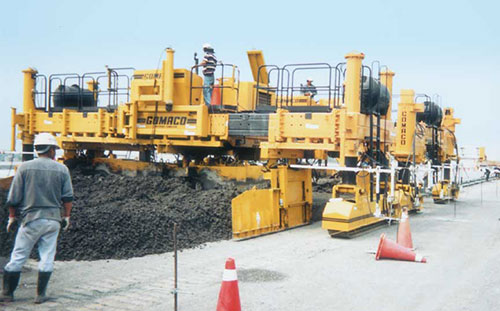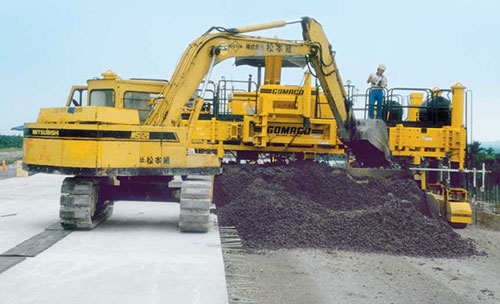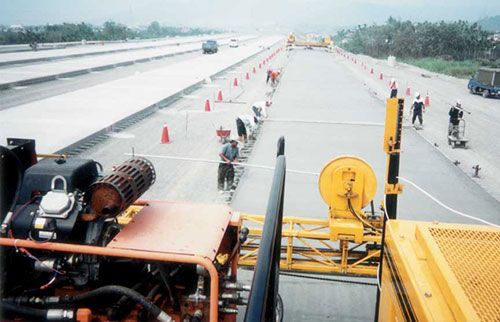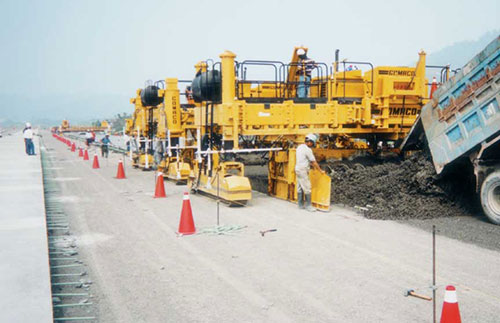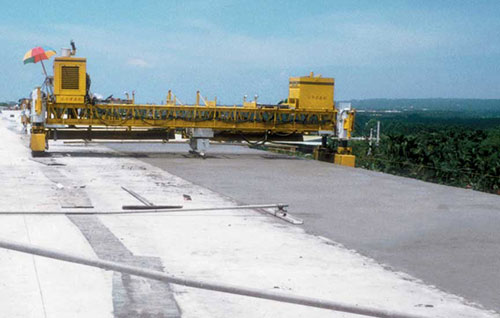GOMACO World Index --- GOMACO World 30.1 - January 2002
Slipforming The Largest Concrete Project in Taiwan
Pacific Construction Company, Ltd., is currently slipforming a project of immense size in Taiwan.
"This project has the largest volume of concrete pavement ever in the country of Taiwan," Su Mou-Cheng, senior job-site manager for Pacific Construction, said. "The project involves three different paving aspects: ramps, toll plaza and mainline highway."
Approximately 2,932,422 ft2 (272,422 m2) of new concrete pavement will be slipformed by the time the project is completed in 2002.
The scope of the project is enormous and Pacific Construction needed reliable paving equipment. The company turned to Mascoris, their GOMACO distributor, to help them determine the right equipment for the project. A GOMACO paving train consisting of a two-track PS-2600 placer/spreader, four-track GP-2600 paver, and T/C-400 texture/cure machine was purchased and put to work on the project.
The formal name of the project is the number C337 Min-Jen Toll Station and Concrete Pavement Section of the Second Freeway of Nun-Tou County. It is located on the Hcung Hsiao East Road in Taipei, the capital city of Taiwan. Perhaps it's simplest to explain the project by the three different sections that comprise it. One of the most challenging aspects on each of the three sections is the different widths required for the paving passes.
Toll Plaza Requires Six Different Widths
Six different widths are required to complete the toll plaza phase. The total width of the plaza is 377 feet (115 m). The thickness of the slab remains constant at 13.8 inches (350 mm).
"There are several profiles and widths changes. We will make six passes at 17.7 feet (5.4 m); eight passes at 20.3 feet (6.2 m); and two passes each at 18.5 feet (5.65 m), 16.4 feet (5 m) and 19.7 feet (6 m)," Mou-Cheng said. "The length of the pours also varies. The longest pass in the middle of the plaza is 1476 feet (450 m) and 17.7 feet (5.4 m) wide. The shortest is only 413 feet (126 m) at 16.4 feet (5 m) wide."
Baskets are placed on grade at 19.7 feet (6 m) intervals. Sidebar inserters, one on each side of the paver, shoot 29.5 inch (750 mm) long bars into the side of the slab every 15.75 inches (400 mm).
A total of 20 paving passes were required to complete the north side of the toll plaza. The south side has not been completed yet.
Ramps
Work on the ramps isn't scheduled to begin until the end of 2001. When that time arrives, five different paving widths will be required.
"There are several ramp profiles," Mou-Cheng explained. "They range from 11.5 feet (3.5 m) to 24.6 feet (7.5 m). It all depends on their location."
The ramps will be 11.8 inches (300 mm) thick. Baskets will be placed on grade at 19.7 feet (6 m) intervals. A center-mounted bar inserter on the front of the GP-2600 paver will insert bars every 15.75 inches (400 mm) for the longitudinal joint.
Seven Lanes of Mainline
The size and amount of paving that makes up the mainline section of this project is overwhelming. It consists of seven lanes of concrete pavement with inner and outer shoulders. The total width of the mainline is 107 feet (32.75 m) and each pour is 3.7 miles (6 km) long and 13.8 inches (350 mm) thick.
Six paving passes will be required to complete the mainline section. The widths are: 17.9 feet (5.45 m), 24 feet (7.3 m), 12 feet (3.65 m), 21.8 feet (6.65 m), and two passes at 15.75 feet (4.8 m).
Baskets are placed on grade at 19.7 feet (6 m) intervals. Sidebar inserters, one on each side of the paver, shoot 29.5 inch (750 mm) long bars into the side of the slab every 15.75 inches (400 mm).
A slipformable concrete mix design with an average slump of one to 1.6 inches (25 to 40 mm) is delivered to the site by dump trucks from the batch plant.
"We like our PS-2600," Mou-Cheng said. "It can easily offer exact concrete for the GP-2600 paver and helps us increase our production and make it faster for precision paving."
A burlap drag is applied behind the paver and the T/C-600 texture/cure applies a 0.12 inch (3 mm) tine.
Production is dependent on concrete delivery. Daily production averages approximately 654 yd3 (500 m3) with the highest reaching 1028 yd3 (786 m3).
"The supply of concrete is the biggest production point," Mou-Cheng said. "We have to carefully plan each segment to make sure we get a good supply and keep our production as high as possible."
The project for Pacific Construction is going well and they should have no problems meeting the April 13, 2002, completion deadline, despite challenges along the way.
Those challenges include being first-time slipformers, a March through August rainy season, and the variety of different widths required for each segment of construction.
"The rainy season is our biggest construction problem," Mou-Cheng explained. "We have to work around the weather and that can be frustrating."
Billy and Roy Liao, from Mascoris, played an integral part in the project. They helped Pacific Construction decide which paving equipment would best fit the project and provided the necessary training for the equipment.
"We didn't know how to do the paving to begin with," Mou-Cheng said. "Mascoris helped us develop a clear picture on the arrangement of the project. They trained us on the equipment, which is very easy to operate, and are helping us accomplish this project."
Subscribe to Receive GOMACO World Magazine

